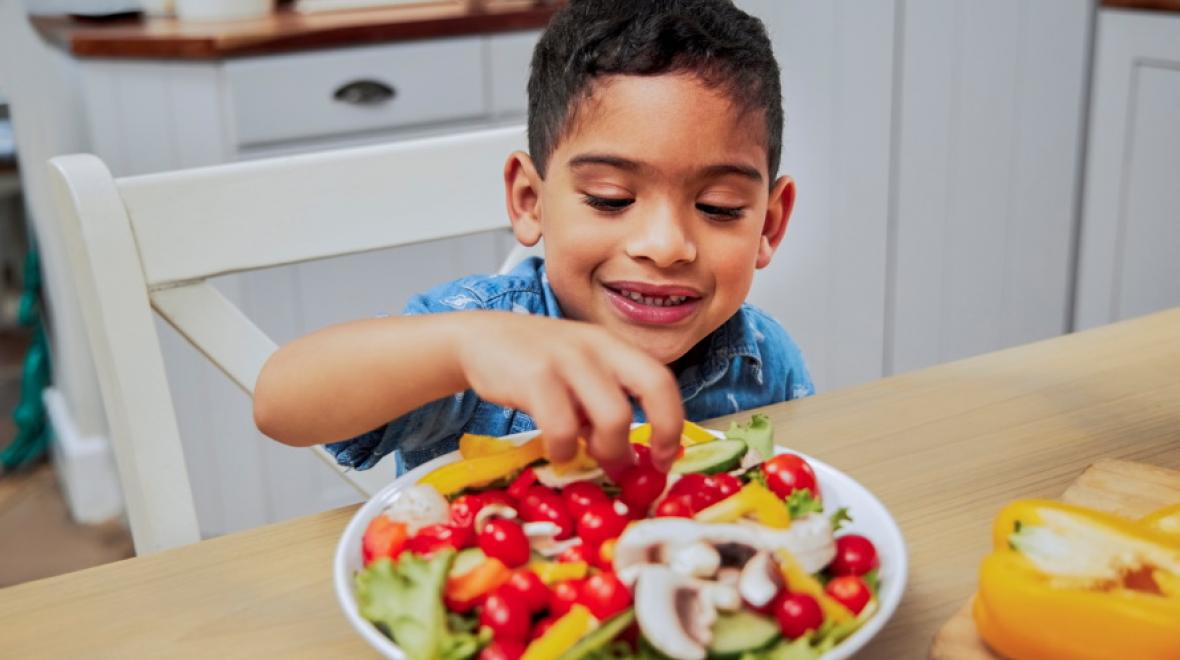
My kids hate veggies — and that's a pretty common thing. It turns out that there are several scientific reasons for that: Children are particularly sensitive to bitter tastes. According to Science Focus magazine, changes in tastebuds can be linked to evolutionary reasons. In other words, our ancestors developed a gene that makes toxins in plants taste bitter to avoid eating the many dangerous plants that surrounded them.
This could explain why your child’s first impulse to bitter or sour foods is to avoid them, and why they need to keep trying different types of veggies to learn to like them as they grow older.
Like adults, all children need vegetables to develop properly. Fruits and vegetables are high in vitamins, fiber and antioxidants, and they help protect your child from serious diseases later in life.
Vegetables can also affect your child’s mental health. In a recent study, researchers analyzed almost 9,000 children to determine if there were any differences between children who ate fruits and vegetables regularly and those who did not. They discovered that those who ate fruit and vegetables had better mental well-being, especially among those who ate at least five portions of fruits and vegetables per day.
According to the current recommendations, children require 1–2 cups of fruit and 1–3 cups of vegetables every day, but the dietary guidelines depend on their age, gender and amount of physical activity.
Getting your child to eat vegetables can be quite a tricky affair. The good news is that there are a few tips that may help increase your child’s vegetable intake. Here are some simple but effective ideas to encourage your kids to eat more veggies.
1. Fill half of your child’s plate with fruits and vegetables.
There is scientific evidence that filling half of your kid's plate with fruits and vegetables increases consumption. In one study, researchers tried two strategies to get kids to eat more: In the first strategy, they added 50 percent more fruit and vegetable side dishes to all the meals that the kids ate. In the second strategy, they replaced an equivalent proportion of foodstuff with fruits and vegetables. For instance, if they added 10 grams of veggies, they took away 10 grams of mac and cheese.
The results of the studies showed that putting more fruit and vegetables on children’s plates increased their consumption, especially when some foodstuffs were substituted for fruits and vegetables.
2. Rename your veggies.
Sometimes kids react in the most unexpected ways. Researchers from Cornell University found that by naming carrots “X-ray vision carrots,” children ate them much much more readily than when those carrots were labeled “food of the day.” If you’re looking for inspiration, another funky name they referenced in the study was “power punch broccoli.”
3. Try alternative ways of serving veggies.
My kids won’t touch cooked carrots, but they are crazy about raw carrot slices served with a pinch of salt. And, against all odds, they love pineapple and kale smoothies. If you want to get your child to eat more vegetables, try baking, roasting or serving them with a sauce or dip (a genius way to encourage picky eaters) to find out what they will appreciate most.
4. Show your child that not all vegetables are bitter.
Most children dislike vegetables because of their bitter taste, but vegetables such as peas or sweetcorn can show them that not all vegetables have the same taste.
5. Involve your child in preparing the veggies.
Cooking vegetables together is a great bonding activity, and it will also increase the chances that your child will want to taste what they prepared. You can start by checking out recipes and letting them choose a vegetable that they would like to try.
6. Grow your own vegetables.
When we let our kids have their own garden and choose the vegetables that they wanted to plant, we found that they were more willing to try “their vegetables.” Encouraging your child to start a veggie garden is an easy way to get them to eat more vegetables. In addition to making them eat more veggies, gardening is also a calming activity that is great for developing fine motor skills.
Children need vegetables because they contain certain nutrients that are helpful for healthy development. The good news is that most of these nutrients are present in other foodstuffs as well. If you’re struggling with your child’s reluctance to eat vegetables, alternatives such as kiwi, grapes, dried apricots, oranges and mangoes will ensure that they get the nutrients they need.
There is no need to panic if your child will simply not touch fruits and vegetables. If they are healthy and have a healthy lifestyle (sufficient sleep and physical activity, a generally good overall diet), keep encouraging them to eat veggies and remember that children’s tastebuds change over time.
You might also like: |











